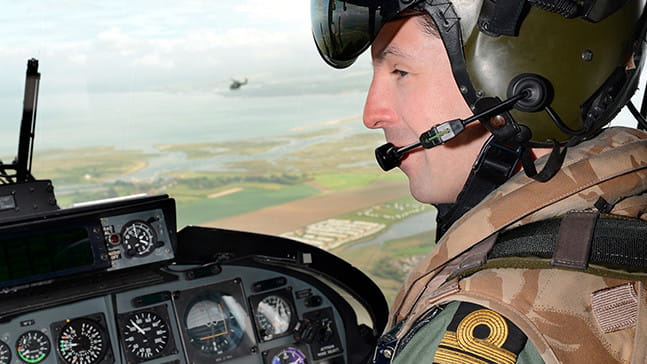Aircrew Officer Pilot
Carve out an aviation career like no other, pushing our cutting-edge aircraft – and yourself – to the limit, all over the world.
High interest role
This is a highly competitive role with a potential long lead time to join.
You may wish to consider joining the Royal Navy in one of these similar roles:
- £31,000 - £120,000
- A-Levels / college qualifications
- Fleet Air Arm
- Aviation
- Officer level
£31,000
£37,000
0%
Free
6 weeks
Travel

Getting my ‘Wings’ was a massive deal. When I applied, all I had was good hand-to-eye coordination. Now I’m in charge of an aircraft worth millions of pounds.
Role details
What you’ll do
Can you think on your feet while you’re in mid-air? You’ll need to as Pilot in the Royal Navy. At all times, and wherever you are in the world, whether you’re flying in pitch black, or carrying out a daytime search and rescue operation. This is a role that’s all about aptitude at altitude, and it goes without saying it takes a special kind of person to do it. Whether you’re flying a Wildcat helicopter or being one of the first to fly the new F-35 Joint Strike Fighter, you’ll become a master of mission-focused flying.
Your role
- Extend our reach on global missions, pushing our cutting-edge aircraft to the limit.
- Specialise in fixed wing or rotary aircraft flying after general flying training, and have all the support and flight time you need to become a world-class pilot.
- Become a key part of our most essential missions, from delivering Royal Marines behind enemy lines in a Merlin Mk3 or Mk4, to providing lifesaving humanitarian aid in the Med.
- Pass rigorous tests to master the skill of mission-focused flying.
Pay & benefits
- A starting salary of at least £31,000 after INT(O)
- Earn up to £37,000 within two years
- Earn additional pay after Flying Training
- Accelerated training and responsibility from day one
- Six weeks of paid holiday every year
- Free medical and dental care
- Subsidised travel and accommodation
- Adventurous training
- Excellent pension scheme
Skills for life
Qualifications you'll gain
- Study for GCSEs, A-Levels, NVQs or even a degree, with funding from us
- Gain a free foundation degree in Aviation Systems Management at 'wing', and BSc of the same name when on the Front Line
Skills you'll develop
- How to fly state-of-the-art aviation machines on global missions
- The ability to use your quick reaction times and work under pressure
Eligibility
- You must be aged 18 to 26
- You’ll need a minimum of 72 UCAS points. These can be accrued from either GCE A/AS levels (or equivalent) or National Diplomas (e.g., BTEC)
- You’ll need at least 5 GCSEs at grades A*-C (9-4) (or Scottish equivalent), which must include English and Mathematics
- You must be a United Kingdom citizen or British Dual National. Dual Nationality restrictions do apply
- You must have lived in the UK for 5 years continuously prior to application
- A minimum height of 151.5cm
- A Body Mass Index (BMI) between 18 and 28 (between 17 and 27 if under 18)
- Must pass CBAT. Specialist Aviation Medical at OASC, RAF Cranwell post AIB.
Skills & Interests
- Able to thrive on responsibility
- Calm under pressure
- A love of aviation and flying
- Able to learn new skills quickly
Joining Process
From picking your role to the first day of training; everything you need to know as an officer
Submit an application
Defence Aptitude Assessment (DAA)
You’ll be tested on: Verbal Reasoning, Numerical Reasoning, Work Rate, Spatial Reasoning, Electrical Comprehension and Mechanical Comprehension.
To prepare, you can practise the DAA
Interview
A formal interview to talk through your suitability for the role
Medical and eye tests
Pre-Joining Fitness Test (PJFT)
Interview
You’ll have a short interview to assess your suitability for a career in the Royal Navy, and to ensure you’re ready for the Admiralty Interview Board (AIB)
Admiralty Interview Board (AIB)
This stage is unique to officers and takes place in two parts. A Pre Recorded Interview (PRI) is an online assessment which assesses your motivation to join the Royal Navy as an officer and your awareness of the Royal Navy. The Group Planning Exercise (GPE) is the second stage of the AIB and is an online competency based assessment which will take place on a separate day to the PRI. It will be conducted in a virtual group environment and you will be assessed on your contribution to the team based on your individual performance
Career Progression
Got a question?
Our virtual recruiter is available to answer your questions 24 hours a day
